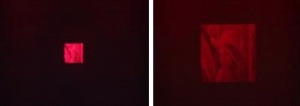Imagine giving a presentation to a roomful of important customers when suddenly the projector fails. You whip out your smartphone, beam your PowerPoint presentation onto the conference room screen, and are back in business within seconds.
This career-saving application and others like it are the promise of a new generation of ultra-small projectors. Now researchers from Japan and Poland have taken an important step toward making such devices more versatile and easier to integrate into portable electronic devices.
 These two still photos show the same holographic image. In the second photo the image has been magnified by the lensless projector. Credit: Tomoyoshi Shimobaba, Chiba University and Michal Makowski, Warsaw University of Technology
These two still photos show the same holographic image. In the second photo the image has been magnified by the lensless projector. Credit: Tomoyoshi Shimobaba, Chiba University and Michal Makowski, Warsaw University of Technology
The team has created a small holographic projection system with a lensless zoom function. When fully developed the system should be cheaper and smaller than other projection systems. The researchers report their findings in a paper published today in the Optical Society's (OSA) open-access journal Optics Express.
Zoom functions magnify an image to fit on an arbitrarily sized screen, but they typically require complicated lenses and mechanical components. "A zoom lens in general projectors occupies a large area in the systems," said Tomoyoshi Shimobaba, a professor in the graduate school of engineering at Chiba University in Japan. "If I remove the zoom lens, the system will be small and cost-saving."
Though the new holographic lensless zoom is not the first lensless zoom system to be developed, Shimobaba notes that other systems require extra components. His team's system requires only a laser and an LCD panel.
In order to achieve a lensless zoom, Shimobaba, his colleagues from Chiba University, and Michal Makowski from the Warsaw University of Technology in Poland turned to holography. Holography is a way to produce images by using the interference pattern of two laser beams to encode and later display the image. By their nature holograms operate without lenses. It is possible to represent a holographic image with numbers and formulas and then calculate how that image can be magnified.
Shimobaba and his team made modifications to the standard magnification formulas to reduce calculation time and preserve image quality. Magnified holograms can suffer from a signal processing effect called aliasing, which can result in visual distortions of the original image. The researchers developed a calculation to reduce aliasing effects and also used a method developed by another team of researchers to reduce the speckle noise effect that can give holograms a grainy appearance. They tested the technique by increasing by nine times the size of a monochrome picture of a woman in a feathered hat.
Currently the footprint of the holographic zoom system is about 160x80x40 millimeters, and Shimobaba believes the researchers can easily shrink it even further. "Currently we use commercial parts," he said. "However, if we customize the components we believe we can develop the smallest projector [to date] because our technique is in principle the simplest." He estimates that the technology could be commercialized in the next five to ten years.
Going forward the researchers plan to refine their mathematical image manipulation techniques to further improve image quality and reduce calculation time. They also plan to test the technique with color images.